Champagne Vinegar Market Research, 2031
The global champagne vinegar market size was valued at $21.4 million in 2021, and is projected to reach $31 million by 2031, growing at a CAGR of 3.8% from 2022 to 2031.
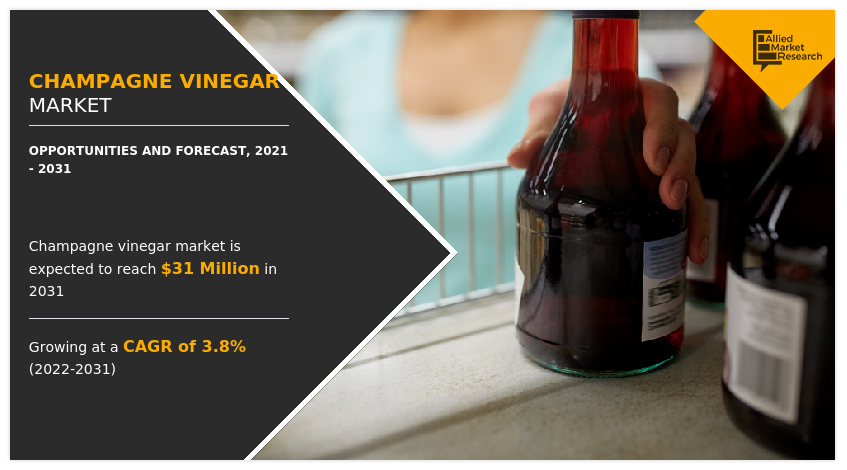
The champagne vinegar market is segmented into Type, Application, Distribution Channel and Champagne Type.
Champagne vinegar is made from sparkling wine or sparkling champagne. The base champagne is mixed with bacteria and then it is aged and fermented into acetic acid. Champagne vinegar is used in various recipes and salads to add flavor and texture. It is widely used in restaurants and hotels to prepare several dishes such as fish, chicken, fruit salsa, and salads. The rising number of HoReCa (hotels, restaurants, and cafes) across the developed and developing nations is expected to drive the demand for champagne vinegar during the forecast period. According to Asian Development Bank 2021, the five largest hotel chains in the Asia-Pacific region – Accor, Marriott International, IHG Hotels & Resorts, Hilton, Hyatt-ready to open over 700 hotels in the Asia-Pacific together. Therefore, a rise in the number of hotels, rising number of international tourists in developing regions, and rising demands for healthy food among the consumers are the major factors that are expected to drive the growth of the champagne vinegar market.
In recent years, there has been an increase in demand for natural and organic products. This has been driven by consumers' increasing awareness regarding the health and environmental benefits of the organic products. Champagne vinegar is made from the same grapes that are used to make champagne, and so it has a similar taste. Manufacturers are increasingly adopting the organic base champagnes made from organically produced grapes to cater to the rising demand for the organic food products. The increase in demand for natural and organic products is the major factor driving the growth of the champagne vinegar market. According to U.S. Department of Agriculture in the year 2019, in India the organic food and beverages retail sales reached to $69.0 million and in 2020, the European organic food market increased by 15% to $52.5 billion. Germany and France remain the largest contributor and contributed 60% to the market share of organic food market in Europe. In addition, the growing popularity of healthy eating and clean eating is also driving the market growth.
The surging popularity of custom-made or tailor-made champagne vinegars is rising significantly in the developed regions like Europe and North America and is expected to boost the champagne vinegar market demand in the near future. When it comes to cooking, every consumer has their own unique choice. Some consumers like to follow traditional recipes, while others prefer to improvise and experiment. In recent years, there has been a growing trend of consumers wanting to customize everything from their clothes to their food. This trend in food sector is offering opportunity for the market players to bring out customized champagne vinegar to add unique flavor to any dish, whether it's a simple salad or a five-course meal. The champagne vinegar market is growing rapidly as more people are becoming interested in healthy and sustainable food options. The champagne vinegar has variety of uses, from cooking to cleaning. Depending on the dish, the vinegar that is required can make all the difference. Therefore several chefs prefer to use customized vinegar blends, tailored to their specific needs. As producers focus on developing new, innovative and customized products, the market players are getting a lucrative growth opportunity.
However, the market is restrained by the wider availability of substitutes. Although champagne vinegar is a quality product, there are many other vinegar products available in the market that can be used as its alternative. The primary substitute for champagne vinegar is white wine vinegar, which is widely available and relatively inexpensive. Other substitutes include apple cider vinegar and balsamic vinegar. This made it difficult for champagne vinegar producers to maintain their margins and profitability. This increased competition makes it difficult for champagne vinegar to gain market share in the overall vinegar market. While the market for champagne vinegar is expected to grow in the upcoming years, it is expected to grow at a slower rate due to the availability of a huge number of substitutes.
The market is segmented based on the type, application, distribution channel, champagne type, and region. On the basis of type, the market is divided into organic and conventional. Based on the application, the champagne vinegar market is categorized into household and commercial. The commercial segment is further segregated into restaurants, hotels, and other. Depending on the distribution channel, the market is segmented into offline and online. On the basis of champagne type, it is divided into pinot meunier, pinot noir, pinot gris, and others. Region-wise, the market is analyzed across North America, Europe, Asia-Pacific, and LAMEA.
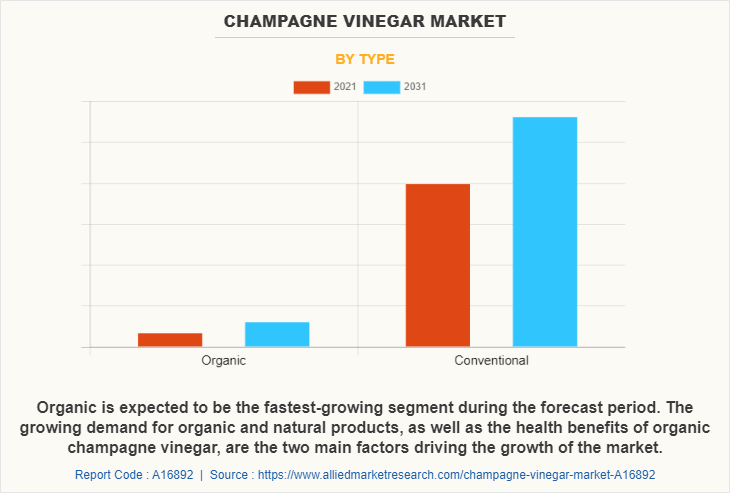
According to the champagne vinegar market forecast, based on type, the organic segment is expected to be the fastest-growing, growing at a CAGR of 6.3% from 2022 to 2031. The rising health consciousness among the consumers and rising awareness regarding the negative impacts of chemical based food products on health and environment are the major factors that are expected to boost the growth of this segment. According to Organic Trade Association in the year 2020-21, Organic revenues exceeded $63 billion, with total annual growth of $1.4 billion. Food sales, which accounted for more than 90% of organic sales, reached $57.5 billion (approximately 2% growth) and non-food sales reached $6.0 billion (7% growth) in U.S.
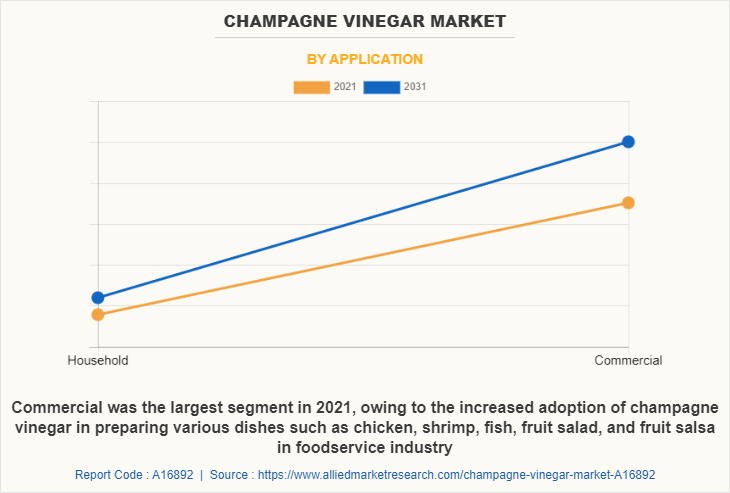
On the basis of application, the commercial segment accounted for 81.9% of the champagne vinegar market share in 2021 and dominated the market. This growth is attributed to the increased adoption of champagne vinegar in preparing various dishes such as chicken, shrimp, fish, fruit salad, and fruit salsa has led to the significant growth of the commercial segment. Moreover, the rising number of HoReCa (hotels, restaurants, and cafes) units in the developing regions is further expected to fuel the growth of this segment in the forthcoming years.
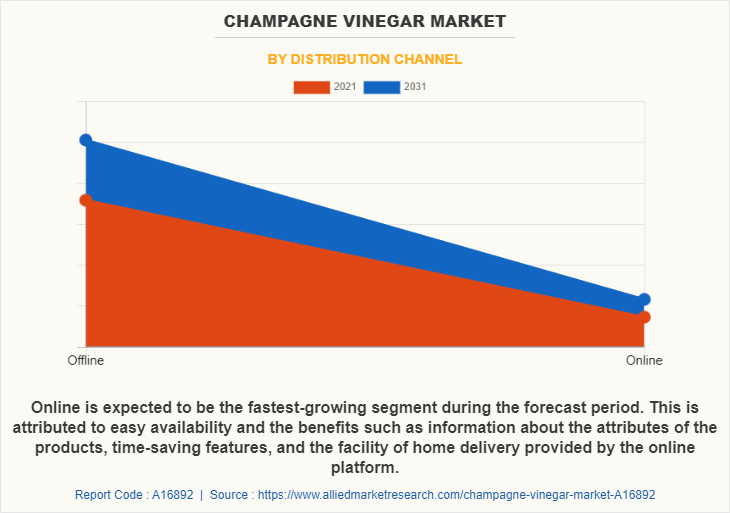
Depending on the distribution channel, the online segment is expected to be the fastest-growing segment during the forecast period. This growth is attributed to the rising adoption of smartphones, growing penetration of online grocery retailers, and rising number of internet users across the globe. According to the International Telecommunication Union (ITU), there were around 4.9 billion internet users at the end of 2021, majority of which accessed to the internet through their smartphones. Consumers are becoming more aware of the many purchase patterns that exist in society as technology advances and internet services become more widely available. The technology attracts the millennials and generation Z and is expected to influence the buying pattern of products. On the other hand, due to time constraints, customers may choose to buy adult incontinence products online. According to the United Nations Conference on Trade and Development (UNCTAD), the e-commerce sector's proportion of total retail sales increased from 16% to 19% in 2020. Furthermore, online sales are expected to grow notably shortly, due to the rapid increase in mobile users. An increase in e-commerce sales, improvements in logistics services, and ease in payment options further boost the champagne vinegar market growth.
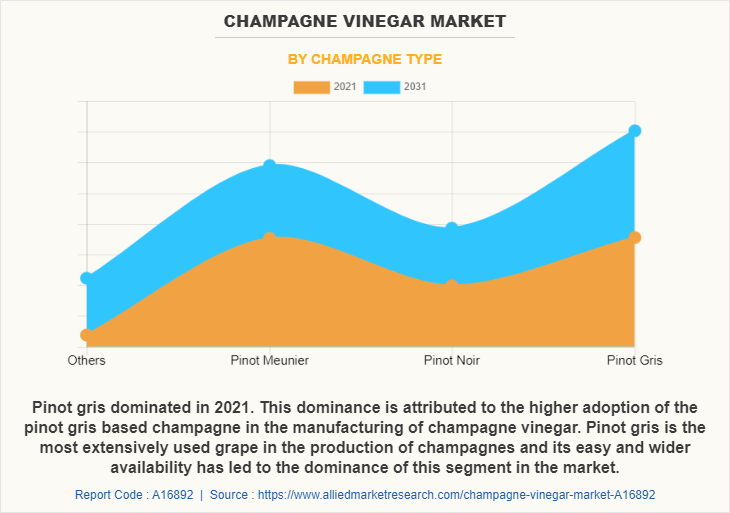
Based on the champagne type, the pinot gris segment dominated the market in 2021. This dominance is attributed to the higher adoption of the pinot gris based champagne in the manufacturing of champagne vinegar. Pinot gris is the most extensively used grape in the production of champagnes and its easy and wider availability has led to the dominance of this segment in the global champagne vinegar market.
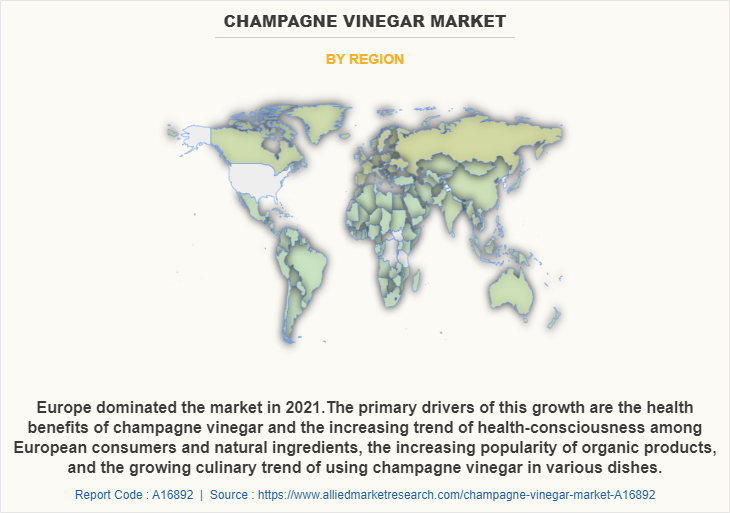
Region-wise, Europe dominated the market accounting for largest champagne vinegar market share in 2021. Germany, France, and Italy are among the top consumers of vinegars in the globe. The presence of several top manufacturers of champagne vinegars and various developmental strategies adopted by them significantly promotes the champagne vinegar market growth. For instance, in November 2018, Stonewall Kitchen has acquired Spruce Naturals, the parent company of Nappa Valley Naturals. A premium brand of certified organic extra virgin olive oils, culinary cooking oils, Italian balsamic vinegars and aged wine vinegars. This strategy aimed at expanding the portfolio of Stonewall Kitchen.
Europe is a rapidly growing market with immense potential. The primary drivers of this growth are the health benefits of champagne vinegar and the increasing trend of health-consciousness among European consumers and natural ingredients, the increasing popularity of organic products, and the growing culinary trend of using champagne vinegar in various dishes. Champagne vinegar is made from the same grapes as champagne wine, and has a similar taste. It is a popular choice for salads, marinades, and sauces. According to Organization for Economic Co-operation and Development (OECD), in the year 2020, the total consumption expenditure of households for food was around $1,026,780 million. The market is further supported by the growing trend of home cooking and the rising popularity of online food delivery. Additionally, the growing popularity of healthier eating habits and the trend towards more natural ingredients.
Asia-Pacific is expected to be the fastest-growing market, growing at a CAGR of 4.5% during the forecast period. China was the dominant market in 2021, accounting for a market share of 29.0%. The rising penetration of various fast food and quick service restaurants along with the rising number of hotels and resorts in the region is expected to significantly drive the growth of the champagne vinegar market in Asia-Pacific region in the foreseeable future.
The major players operating in the global champagne vinegar industry includes Antichi Colli Srl, Bellindora, Charbonneaux Brabant, Cibaria International, Classic Wines Vinegar, Evoolution, Fiore Artisan Olive Oil and Vinegar, Fleischmann's Vinegar, Hillstone Olive Oil, Kimberley Wine Vinegars, O Olive Oil and Vinegar, Olive Oil and Beyond, Sparrow Lane, Stonewall Kitchen, Wellspent Market. These market players are constantly engaged in the various developmental strategies such as acquisitions, mergers, and product launches to exploit market opportunities and gain market share.
Key Benefits For Stakeholders
- This report provides a quantitative analysis of the champagne vinegar market segmentation, current trends, estimations, and dynamics of the champagne vinegar market analysis from 2021 to 2031 to identify the prevailing champagne vinegar market opportunities.
- The market research is offered along with information related to key drivers, restraints, and opportunities.
- Porter's five forces analysis highlights the potency of buyers and suppliers to enable stakeholders make profit-oriented business decisions and strengthen their supplier-buyer network.
- In-depth analysis of the champagne vinegar market size and segmentation assists to determine the prevailing market opportunities.
- Major countries in each region are mapped according to their revenue contribution to the global champagne vinegar industry.
- Market player positioning facilitates benchmarking and provides a clear understanding of the present position of the market players.
- The report includes the analysis of the regional as well as global champagne vinegar market trends, key players, market segments, application areas, and market growth strategies.
Champagne Vinegar Market Report Highlights
| Aspects | Details |
| By Type |
|
| By Application |
|
| By Distribution Channel |
|
| By Champagne Type |
|
| By Region |
|
| Key Market Players | Hillstone Olive Oil, Cibaria International, Olive Oil and Beyond, Evoolution, Kimberley Wine Vinegars, Sparrow Lane, Classic Wine Vinegar, Fiore Artisan olive oil and vinegar, charbonneaux brabant s.a., O Olive Oil & Vinegar, Antichi Colli Srl, Fleischmann's Vinegar Company, stonewall kitchen, Bellindora, Wellspent Market |
Analyst Review
Based on the insights of the top CXOs, the champagne vinegar market may experience a significant growth from the commercial segment owing to an increased demand for the tailor-made champagne vinegar offered by some of the major market players. For instance, Charbonneaux Brabant, a leading global vinegar supplier, offers tailor-made vinegars to their customers, based on the demand and specific requirement and instructions from the customer. The tailor-made champagne vinegar is used to create a specific and unique recipe by the food manufacturers.
The CXOs further added that the potential utilization of champagne vinegar and other varieties of vinegars may open up new prospects and opportunities for the vinegar manufacturers in the foreseeable future. The champagne vinegar can be used as a food additive and owing to its physical abnormalities, the champagne vinegar can also be used in preparing medicines. The vinegar can be used as an antioxidant, anti-obesity, antimicrobial, and antitumor agent in the pharmaceutical industry. Moreover, vinegars can help in maintaining body weight, reduce cholesterol, and control diabetes. Moreover, the antimicrobial functions of vinegar has led to its applications in treating head lice, ear infections, and nail fungus. Therefore, the characteristics of the vinegar makes it an ideal ingredient to be potentially used in the manufacturing of a variety of medicines in the pharmaceutical industry and this factor is anticipated to offer numerous growth opportunities to the manufacturers of champagne vinegar in the forthcoming years.
The global champagne vinegar market size was valued at $21.4 million in 2021, and is projected to reach $31 million by 2031
The global Champagne Vinegar market is projected to grow at a compound annual growth rate of 3.8% from 2022 to 2031 $31 million by 2031
The major players operating in the global champagne vinegar industry includes Antichi Colli Srl, Bellindora, Charbonneaux Brabant, Cibaria International, Classic Wines Vinegar, Evoolution, Fiore Artisan Olive Oil and Vinegar, Fleischmann's Vinegar, Hillstone Olive Oil, Kimberley Wine Vinegars, O Olive Oil and Vinegar, Olive Oil and Beyond, Sparrow Lane, Stonewall Kitchen, Wellspent Market.
Region-wise, Europe dominated the market accounting for largest champagne vinegar market share in 2021.
Surge in the number of hotels and an increase in the number of tourist activities across the emerging economies drives the growth of the global champagne vinegar market.
Loading Table Of Content...



